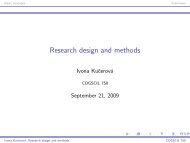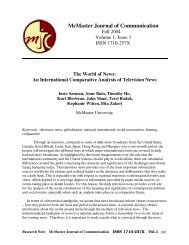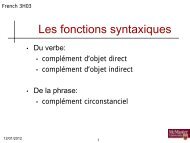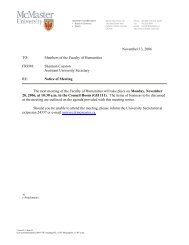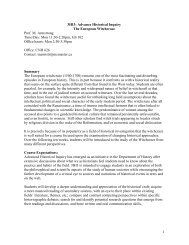The Syntax of Givenness Ivona Kucerová
The Syntax of Givenness Ivona Kucerová
The Syntax of Givenness Ivona Kucerová
You also want an ePaper? Increase the reach of your titles
YUMPU automatically turns print PDFs into web optimized ePapers that Google loves.
given counterpart, and (ii) why is one instance <strong>of</strong> G-movement sometimes sufficient but<br />
more than one instance <strong>of</strong> G-movement is required other times. I will leave the questions<br />
open for now and I will come back to them in chapter 4.<br />
In this section, I have provided two arguments that G-movement is a last resort syntactic<br />
operation. <strong>The</strong> arguments were based on two facts about the distribution <strong>of</strong> pronouns in<br />
Czech. First, I have shown that pronouns do not undergo G-movement. I have suggested<br />
that this shows that G-movement applies only to elements that are to be interpreted as given<br />
but that at the same time do not enter the derivation lexically marked as given. <strong>The</strong> second<br />
part <strong>of</strong> this section addressed the question <strong>of</strong> what happens if an element cannot undergo G-<br />
movement because <strong>of</strong> independent syntactic restrictions on movement, such as islands. We<br />
have observed that in such configurations an element must already come from the lexicon<br />
marked as given because there is no other way it could be marked as given in syntax. Last,<br />
we have seen that if an element is trapped within an island but high enough in the structure,<br />
the fact that it cannot undergo movement does not matter because the relevant interpretation<br />
can be obtained without movement. Thus G-movement is not required.<br />
1.6 Summary<br />
In this chapter, I have <strong>of</strong>fered several generalizations about the distribution <strong>of</strong> given and<br />
new information in a Czech clause. I have shown that in an optimal configuration, the<br />
given part linearly precedes the new part and the partition is marked by a verb which can<br />
be on either side <strong>of</strong> the partition. I have proposed to account for the linear order facts in<br />
terms <strong>of</strong> G-movement: an economy restricted movement that requires a given element to<br />
move only if such an element is asymmetrically c-commanded by a new element and is not<br />
lexically marked as given. I have presented several arguments in favor <strong>of</strong> understanding G-<br />
movement as a last resort operation, including arguments from the distribution <strong>of</strong> pronouns<br />
and the semantic ambiguity <strong>of</strong> certain strings. We have also seen that elements that are<br />
lexically given do not undergo G-movement and that the linear partition between given and<br />
new is not always perfect. In chapters 2 and 3 I will develop the current toy system in detail.<br />
After that, in chapter 4, I will refine my answer to the question <strong>of</strong> how G-movement is<br />
motivated and how it is treated by the interfaces. In particular, I will argue that G-movement<br />
is a free syntactic movement, the purpose <strong>of</strong> which is to create a configuration which can be<br />
semantically interpreted in a way that is required by the contextually established common<br />
ground.<br />
40





